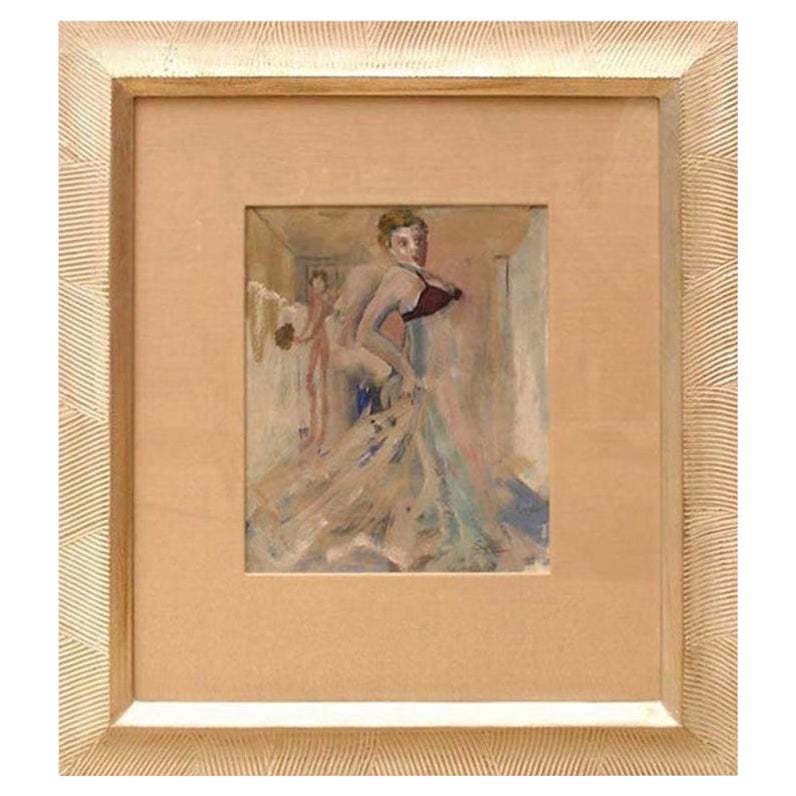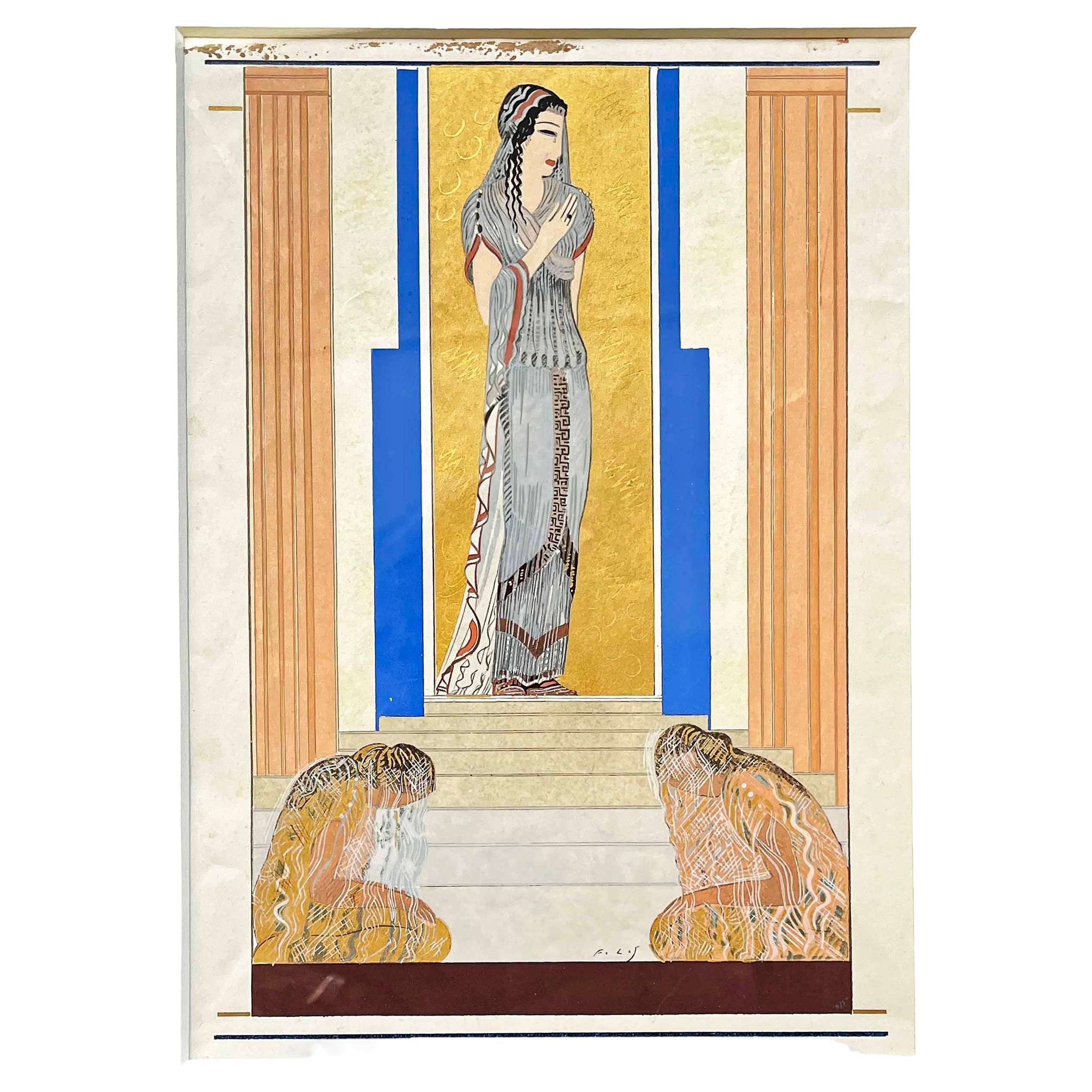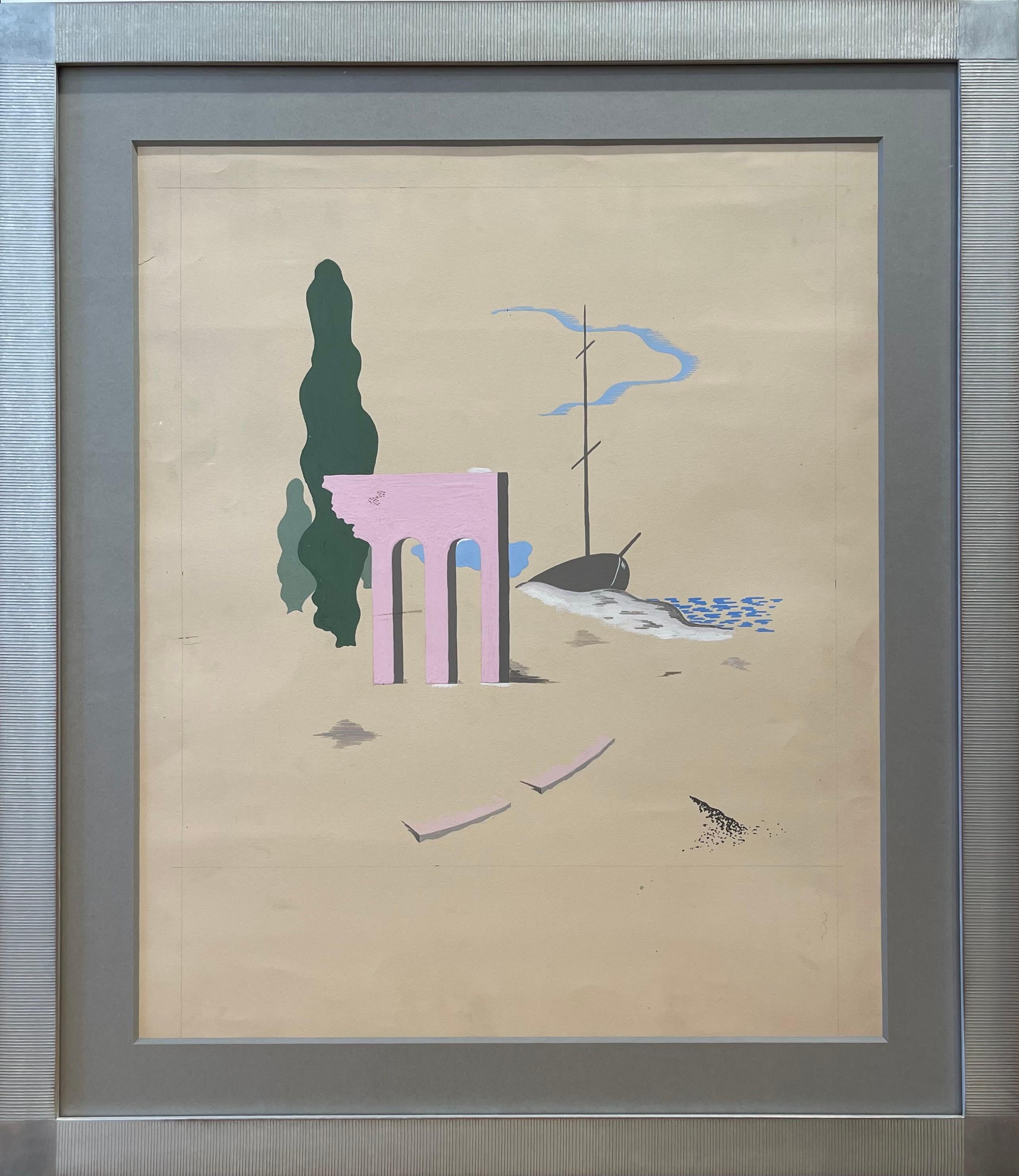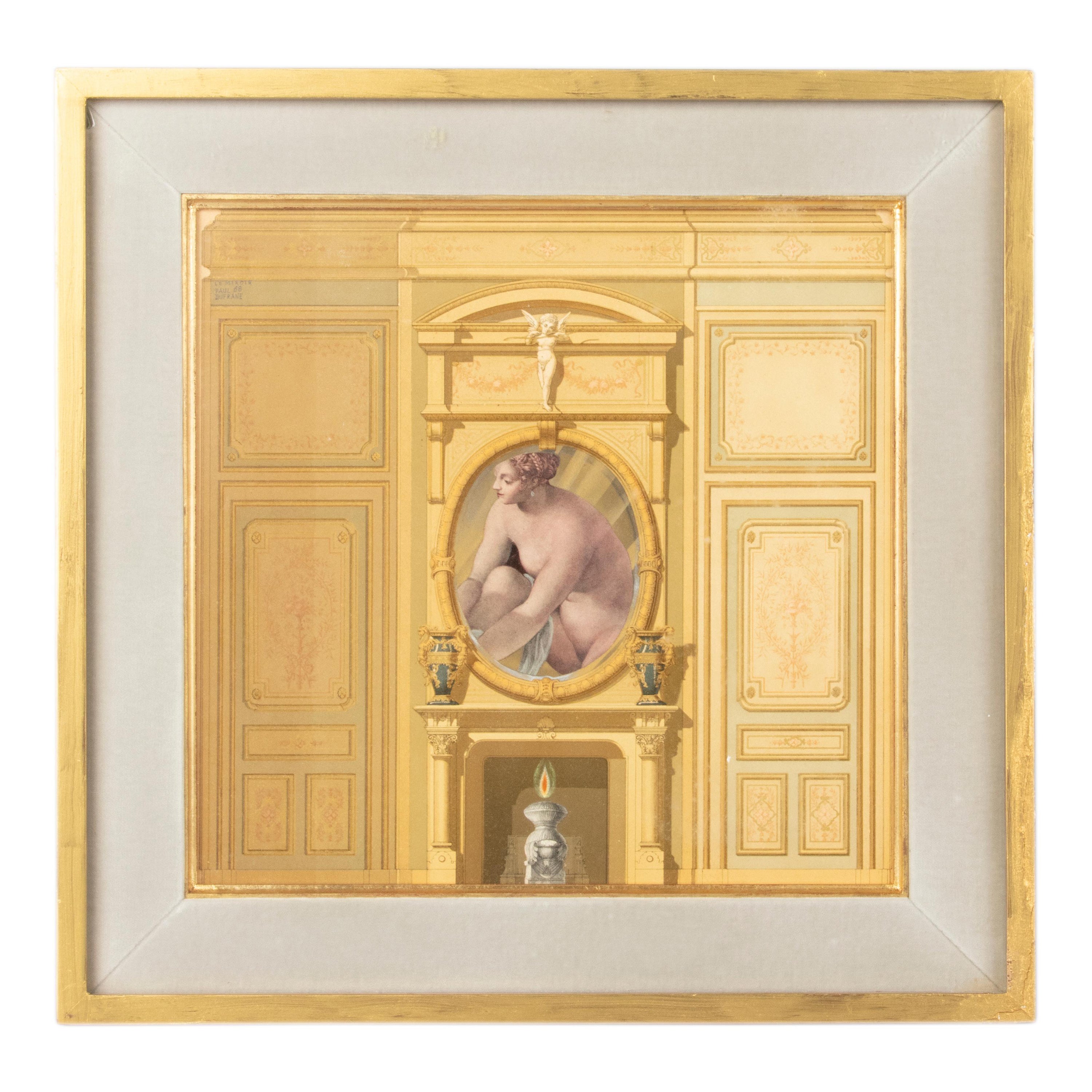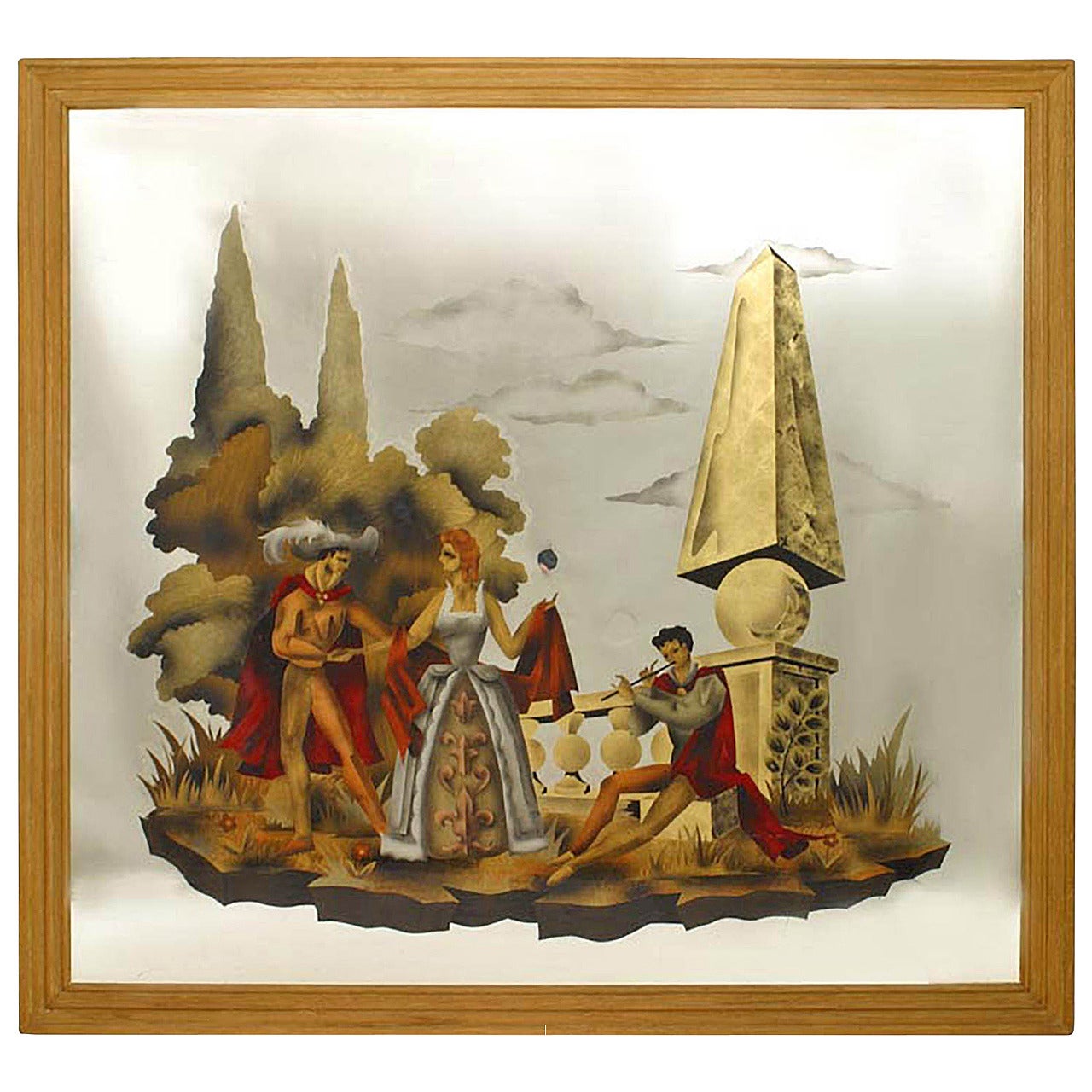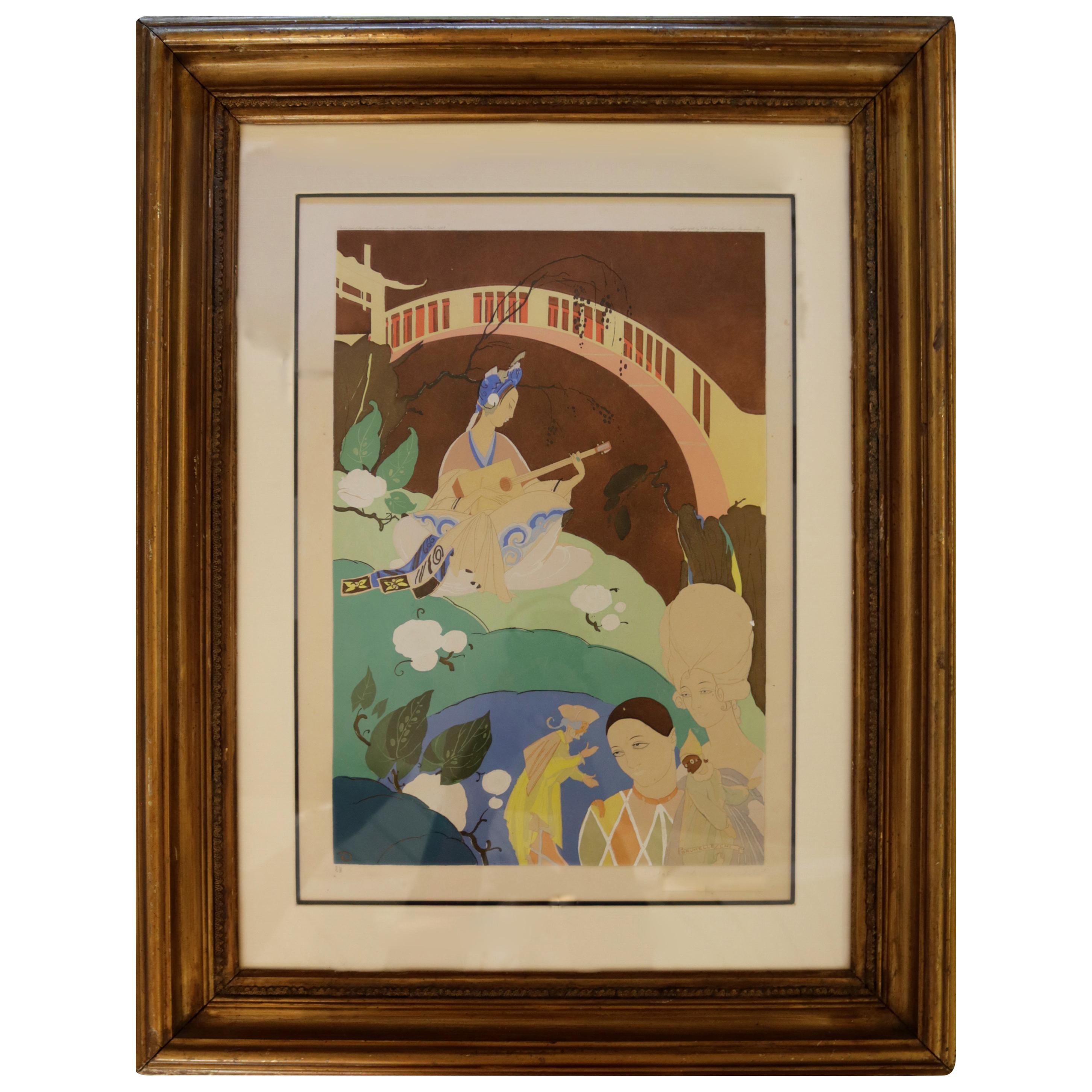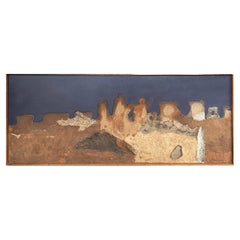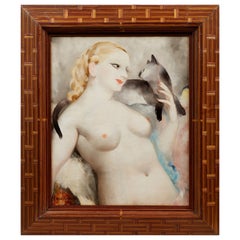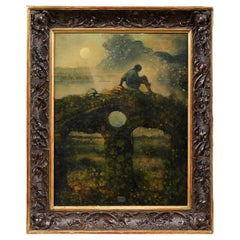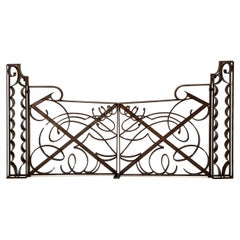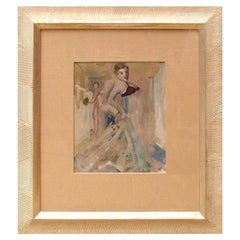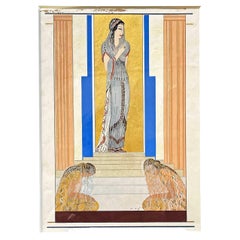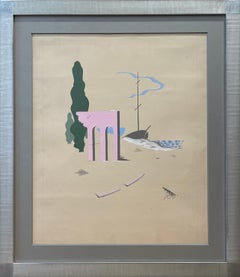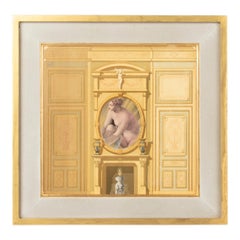Items Similar to Georges Lepape - "La Femme, l'Enfant et la Famille", Peinture et Miroir
Want more images or videos?
Request additional images or videos from the seller
1 of 9
Georges Lepape - "La Femme, l'Enfant et la Famille", Peinture et Miroir
$10,396.78
£7,793.03
€8,800
CA$14,283.41
A$15,946.09
CHF 8,355.51
MX$195,195.75
NOK 106,115.05
SEK 100,053.02
DKK 66,988.81
About the Item
Georges Lepape (1887-1971) - "La Femme, l'Enfant et la Famille"
Technique : Techniques mixtes sur toile
Date de création : Vers 1937
Dimensions : H : 195 cm L : 131 cm
Signature : Signé dans le décor
Historique :
Ce projet constitue une étude préparatoire pour la fresque réalisée en 1937 par Georges Lepape. L'œuvre finale décorait l'arc d'entrée du Pavillon de la Femme, de l'Enfant et de la Famille lors de l'Exposition Universelle de Paris.
Bibliographie :
Claude LEPAPE & Thierry DEFERT, Georges Lepape ou l'élégance illustrée, Éditions Herscher, Paris, 1983, p. 164 (photographie de l'artiste devant la fresque en 1937).
Biographie de Georges Lepape :
Élève à l'Académie Humbert, Georges Lepape expose dès 1910 au Salon d'Automne, où il rencontre le couturier Paul Poiret, avec qui il se lie d'amitié. En 1911, il illustre pour lui Les Choses de Paul Poiret vues par Georges Lepape, ouvrage considéré comme son chef-d'œuvre.
Collaborateur de nombreux magazines de mode influents (Gazette du bon ton, Harper's Bazaar, Vanity Fair, Femina, Vogue, Les Feuillets d'art), il marque son époque par un style précurseur de la ligne claire, influencé par l'orientalisme, les miniatures persanes et les Ballets Russes.
En 1920, il participe à l'exposition La Mode du XXe siècle vue par les peintres au Musée des Arts Décoratifs de Paris. En 1926, Condé Nast l'invite à New York, où il réalise plusieurs couvertures remarquées pour Vogue US.
Pluridisciplinaire, il excelle dans des domaines variés : affiches, programmes de théâtre, textiles, éventails et catalogues publicitaires (Wallace & Draeger). En 1923, il conçoit des décors pour L'Oiseau Bleu de Maurice Maeterlinck et des costumes de théâtre.
Après la Seconde Guerre mondiale, il se consacre principalement à l'illustration et la publicité, signant une trentaine de livres (Paul Géraldy, Sacha Guitry, Alfred de Musset, Platon).
Grand amateur de Sainte-Maxime (Var), il y fait construire sa villa "Les Oursins" sur les rochers, selon les plans de son beau-père Gustave Lausanne.
Georges Lepape s'éteint le 15 février 1971 à Bonneval (Eure-et-Loir).
------------
Georges Lepape (1887-1971) - "The Woman, the Child and the Family"
Medium: Mixed media on canvas
Creation Date: Circa 1937
Dimensions: H: 195 cm W: 131 cm
Signature: Signed within the decor
History:
This project is a preparatory study for the fresco created in 1937 by Georges Lepape, which adorned the entrance arch of the Pavilion of Women, Children, and Families at the Paris Universal Exhibition.
Bibliography:
Claude LEPAPE & Thierry DEFERT, Georges Lepape or Illustrated Elegance, Éditions Herscher, Paris, 1983, p. 164 (photograph of the artist in front of the fresco in 1937).
Biography of Georges Lepape:
A student at the Académie Humbert, Georges Lepape exhibited at the Salon d'Automne in 1910, where he met the fashion designer Paul Poiret, forming a close friendship. In 1911, he illustrated Les Choses de Paul Poiret vues par Georges Lepape, considered his masterpiece.
He contributed to leading fashion magazines such as Gazette du bon ton, Harper's Bazaar, Vanity Fair, Femina, Vogue, and Les Feuillets d'art. His style, a precursor of ligne claire, was influenced by Orientalism, Persian miniatures, and the Ballets Russes.
In 1920, he participated in 20th-Century Fashion as Seen by Painters at the Museum of Decorative Arts in Paris. In 1926, Condé Nast invited him to New York, where he created iconic covers for Vogue US.
Versatile in various fields, he worked on posters, theater programs, fabrics, fans, and advertising catalogs (Wallace & Draeger). In 1923, he designed set decorations for L'Oiseau Bleu by Maurice Maeterlinck and theater costumes.
After World War II, he focused on advertising and book illustrations, creating around thirty illustrated works, including Paul Géraldy, Sacha Guitry, Alfred de Musset, and Plato.
A frequent visitor to Sainte-Maxime (Var), he built his villa "Les Oursins" on the rocks, designed by his father-in-law Gustave Lausanne.
Georges Lepape passed away on February 15, 1971, in Bonneval (Eure-et-Loir), France.
- Creator:Georges Lepape (Artist)
- Dimensions:Height: 76.78 in (195 cm)Width: 51.58 in (131 cm)Depth: 1.97 in (5 cm)
- Style:Art Deco (Of the Period)
- Materials and Techniques:
- Place of Origin:
- Period:
- Date of Manufacture:1937
- Condition:Wear consistent with age and use. Minor losses.
- Seller Location:NEUILLY-SUR-SEINE, FR
- Reference Number:1stDibs: LU9892240717162
About the Seller
No Reviews Yet
Recognized Seller
These prestigious sellers are industry leaders and represent the highest echelon for item quality and design.
Established in 1992
1stDibs seller since 2024
- ShippingRetrieving quote...Shipping from: Saint-Ouen-sur-Seine, France
- Return Policy
Authenticity Guarantee
In the unlikely event there’s an issue with an item’s authenticity, contact us within 1 year for a full refund. DetailsMoney-Back Guarantee
If your item is not as described, is damaged in transit, or does not arrive, contact us within 7 days for a full refund. Details24-Hour Cancellation
You have a 24-hour grace period in which to reconsider your purchase, with no questions asked.Vetted Professional Sellers
Our world-class sellers must adhere to strict standards for service and quality, maintaining the integrity of our listings.Price-Match Guarantee
If you find that a seller listed the same item for a lower price elsewhere, we’ll match it.Trusted Global Delivery
Our best-in-class carrier network provides specialized shipping options worldwide, including custom delivery.More From This Seller
View AllJean Piaubert - "Presence", 1965, Huile, sable et gravier sur panneau intitulé
Located in NEUILLY-SUR-SEINE, FR
Jean Piaubert - "Presence", 1965
Technique : Huile, sable et gravier sur panneau
Signature : Signé en bas à droite
Dimensions : H : 60 cm L : 150 cm
Provenance :
Vente Me Lombrail...
Category
Vintage 1960s French Art Deco Paintings
Materials
Sandstone
Miçao Kono - "Woman with Cat" (1934) - Huile sur toile
By Micao Kono
Located in NEUILLY-SUR-SEINE, FR
Miçao Kono - "Woman with Cat" (1934)
Type : Huile sur toile
Signature : Signée et datée 1934 en bas à gauche et au dos de l’œuvre
Encadrement : Exceptionnel cadre Art Déco en marqu...
Category
Mid-20th Century Japanese Art Deco Paintings
Materials
Paint
Eugène Berman (1899-1972) - Oil on canvas "Paludia"
By Eugene Berman
Located in NEUILLY-SUR-SEINE, FR
Eugène Berman - "Paludia" (1967-1968)
Type : Huile sur toile
Signature : Monogrammée en bas au centre, contresignée au dos
Date de création : 1967-Rome-1968
Dimensions : 67 cm x 54 cm
Encadrement : Rare cadre Troubadour en papier mâché, circa 1840
Expositions et provenance :
Étiquette d’exposition de la Galerie Lucie Weill au dos
Annotations de la Galerie Forni à Bologne
Bibliographie :
Galerie Lucie Weill, Les Néo-romantiques: Christian Bérard, Léonid et Eugène Berman, Pavel Tchelitchew, Paris, 1971.
"Paludia" est une huile sur toile réalisée par Eugène Berman entre 1967 et 1968 à Rome. L'œuvre, représentative de son style néo-romantique, est empreinte de mélancolie et de poésie, avec une touche onirique caractéristique de son approche théâtrale de la composition.
Son cadre troubadour en papier mâché, rare et datant de circa 1840, confère à l'œuvre une aura historique et une mise en valeur singulière, dans l'esprit des cabinets de curiosités qu'affectionnait l'artiste.
Biographie d'Eugène Berman (1899-1972) :
Né le 4 novembre 1899 à Saint-Pétersbourg, Eugène Berman est un peintre et décorateur de théâtre d’origine russe, naturalisé américain. Il est le frère de Léonide Berman.
Son éducation artistique débute en Europe occidentale, avec des formations en Allemagne, Suisse et France, où il suit les cours de Pavel Naumov et Sergey Gruzenberg entre 1914 et 1918. Après avoir quitté la Russie en 1918, il étudie à l'Académie Ranson à Paris, sous la direction de Maurice Denis et Édouard Vuillard.
Inspiré par Giorgio de Chirico et Picasso, il expose ses œuvres (portraits et paysages) aux Salons d’Automne et des Tuileries entre 1923 et 1927. Il promeut, aux côtés de son frère, une forme de peinture poétique et symboliste.
En 1935, il émigre aux États-Unis, où il travaille comme décorateur de théâtre tout en poursuivant son œuvre picturale. Il devient citoyen américain en 1937.
Il meurt le 14 décembre 1972, à Rome ou New York.
Cabinet de curiosités et collection personnelle :
Eugène Berman possédait une importante collection d’objets anciens, comprenant :
Céramiques, statuettes, sculptures, verrerie, textiles, tapis de diverses civilisations (précolombienne, africaine, de Nouvelle-Guinée, de Colombie-Britannique, égyptienne, copte, grecque, étrusque, romaine).
Mobilier italien et latino-américain du XVIe et XVIIe siècles.
Œuvres d’amis artistes, dont Mirko, Ernst, Cagli, Cremoni.
Sa collection fut installée dans un appartement romain, transformé en un véritable cabinet de curiosités, situé au dernier étage d’un palais proche de la Piazza del Popolo.
------------
Eugène Berman - "Paludia" (1967-1968)
Type: Oil on canvas
Signature: Monogrammed at the bottom center, countersigned on the back
Creation Date: 1967-Rome-1968
Dimensions: 67 cm x 54 cm
Frame: Rare Troubadour-style papier-mâché frame, circa 1840
Exhibitions and Provenance:
Exhibition label from Galerie Lucie Weill on the back
Annotations from Forni Gallery in Bologna
Bibliography:
Galerie Lucie Weill, The Neo-Romantics: Christian Bérard, Léonid and Eugène Berman, Pavel Tchelitchew, Paris, 1971.
"Paludia" is an oil on canvas created by Eugène Berman between 1967 and 1968 in Rome. Representative of his neo-romantic style, the piece exudes melancholy and poetic introspection, with a dreamlike quality reflecting his theatrical approach to composition.
The rare papier-mâché Troubadour frame, dating from circa 1840, enhances the historical aura of the work, aligning with the artist’s deep appreciation for curiosities and antiquities.
Biography of Eugène Berman (1899-1972):
Born on November 4, 1899, in Saint Petersburg, Eugène Berman was a Russian-born American painter and theater designer. He was the brother of Léonide Berman.
He received his early artistic education in Western Europe, training in Germany, Switzerland, and France, with studies under Pavel Naumov and Sergey Gruzenberg between 1914 and 1918. Leaving Russia in 1918, he studied at Académie Ranson in Paris, under the guidance of Maurice Denis and Édouard Vuillard.
Influenced by Giorgio de Chirico and Picasso, he exhibited his works (portraits and landscapes) at the Salons d’Automne and des Tuileries between 1923 and 1927. Alongside his brother, he championed a poetic and symbolic form of painting.
In 1935, he emigrated to the United States, working as a theater designer while continuing to produce allegorical works. He became an American citizen in 1937.
He passed away on December 14, 1972, in Rome or New York.
Cabinet of Curiosities and Personal Collection:
Eugène Berman owned a significant collection of antique artifacts, including:
Ceramics, statuettes, sculptures, glassware, textiles, and rugs from Pre-Columbian, African, New Guinea, British Columbia, Egyptian, Coptic, Greek, Etruscan, and Roman civilizations.
Italian and Latin American furniture...
Category
Vintage 1960s North American American Classical Paintings
Materials
Paint
Edgar Brandt - Paire de Grilles d'Intérieur en Fer Forgé (circa 1925-1930)
By Edgar Brandt
Located in NEUILLY-SUR-SEINE, FR
Edgar Brandt - Paire de Grilles d'Intérieur en Fer Forgé (circa 1925-1930)
Type : Paire de grilles d'intérieur en fer forgé
Date de création : Vers 1925-1930
Dimensions : Hauteur ma...
Category
Mid-20th Century European Art Deco Doors and Gates
Materials
Metal
Émile Just Bachelet - Sculpture - "Tendresse" (circa 1930)
By Émile Just Bachelet
Located in NEUILLY-SUR-SEINE, FR
Émile Just Bachelet - Sculpture - "Tendresse" (circa 1930)
Type : Sculpture en taille directe sur pierre
Date de création : Vers 1930
Dimensions : H : 54 cm
Bibliographie :
Détail ...
Category
Mid-20th Century French Art Deco Figurative Sculptures
Materials
Stone
Vitrine exceptionnelle par Léon Jallot – 1910
By Léon Jallot
Located in NEUILLY-SUR-SEINE, FR
Vitrine exceptionnelle par Léon Jallot – 1910
Magnifique vitrine en bois de hêtre signée Léon Jallot, datant de 1910.
Modèle "Fleurs et feuilles de cerisier stylisées", présenté au ...
Category
Vintage 1910s French Mid-Century Modern Vitrines
Materials
Wood
You May Also Like
Art Deco Belgium Gouache and Watercolor Painting by Leo Engels Custom Framed
By Leo Engels
Located in North Miami, FL
This sensual and erotic like one of a kind original vintage European work of art by Leo Engels is of the Art Deco period. It is a combination of gouache and watercolor. It is Belgium...
Category
Vintage 1930s Belgian Art Deco Paintings
Materials
Silver Leaf
"Greek Goddess", Original Art Deco Painting for "L'Odyssée" by Schmied, 1928
By François-Louis Schmied
Located in Philadelphia, PA
This richly detailed painting of a Greek goddess in Classical robes, standing atop a flight of steps with two heavily veiled attendants below, was made by François-Louis Schmied, one...
Category
Vintage 1920s French Art Deco Paintings
Materials
Paint
$6,000 Sale Price
20% Off
Original Watercolor by Boris Lacroix, France, Art Déco, circa 1930
By Jean Boris Lacroix
Located in Paris, FR
Original watercolor by Boris Lacroix (1902-1984) representing architecture elements, a boat and the seaside.
Wall paper design from the Art Deco p...
Category
Vintage 1930s French Art Deco Decorative Art
Materials
Paper
Collage Artwork by Paul Dufrane Dated 1968, 'LE MIRROIR'
Located in Casteren, Noord-Brabant
Beautiful and atmospheric collage artwork by the Belgian artist Paul Dufrane. The painting is entitled 'The mirror', it is composed of various antique pri...
Category
Vintage 1960s Belgian Mid-Century Modern Decorative Art
Materials
Paper
Pierre Lardin French Mid-Century Painted Wall Mirror
By Pierre Lardin
Located in Queens, NY
French mid-century (1940s) oak framed horizontal wall mirror with reverse glass painted Neoclassic scenes. (attributed to Pierre Lardin).
Category
Vintage 1940s French Art Deco Paintings
Materials
Oak, Mirror
Oriental Lithograph and Watercolor by Umberto Brunelleschi
By Umberto Brunelleschi
Located in Pasadena, CA
The background of this intricate lithograph and watercolor from France depicts a geisha playing a musical instrument, while the foreground depicts a harlequin and two women wearing m...
Category
Early 20th Century French Mid-Century Modern Paintings
Materials
Paper
$400 Sale Price
57% Off
More Ways To Browse
Le Fanion
Decorative Arts New York Mirror
Harp Mirror
1920s Vanity Set
Plato Vintage
Nast A Paris
Oriental Vanity
Vintage Chef Poster
La Mode Illustree
Miniature Theatre
Paul Poiret Art Deco Vanity
Antique Cast Bronze Bells
Antique China Cabinet With Mirror
Antique Fashion Clocks
Antique Idols
Antique Ivory Chest
Antique Japanese Cupboard
Antique Kitchen Queen Cabinet
